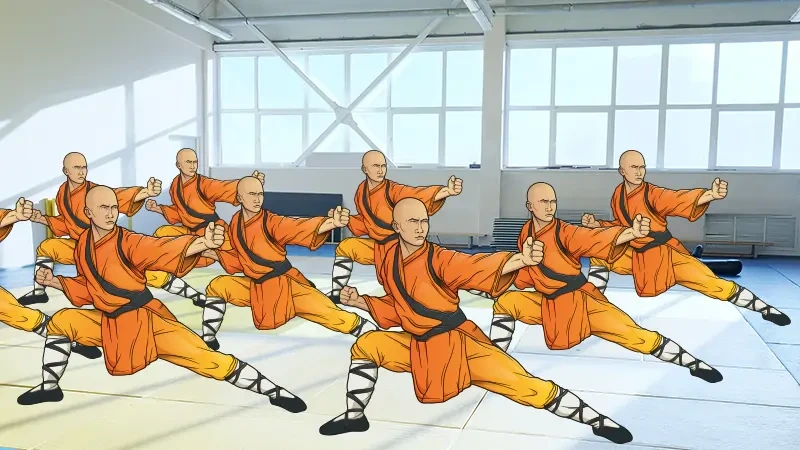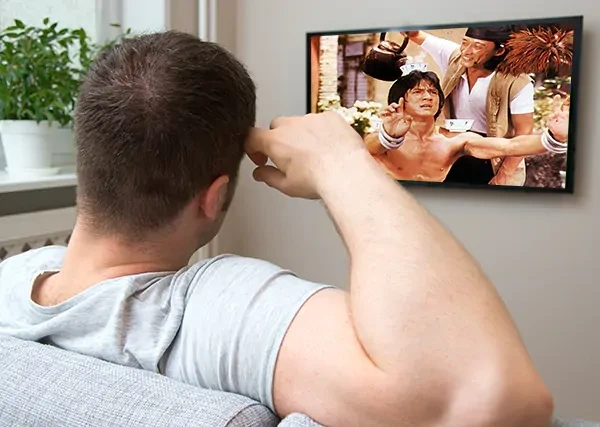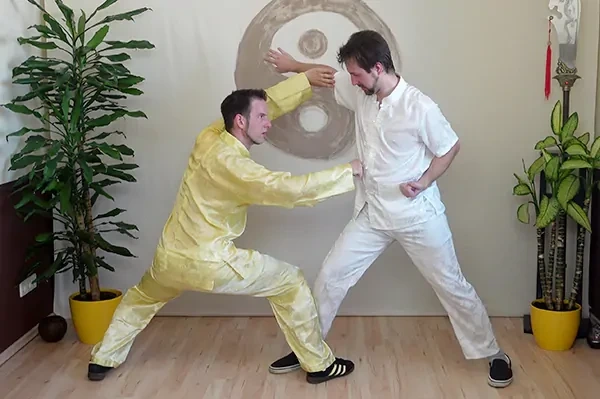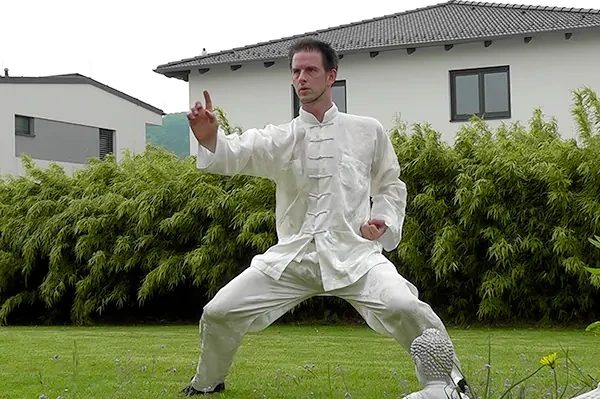A young Man's Kung Fu Journey
Red Pill Edition
Welcome to Wonderland! :)
Now that you decided to look behind the curtain, you will find out what would have been different if Steve had found a genuine Kung Fu school.
My comments are not intended to belittle others in any way. Kung Fu instructors are usually sincere and mean well but, sadly, most haven’t been exposed to original high-level teachings and their understanding is therefore limited, or influenced, by popular believes.
My aim is to highlight how and where Kung Fu training deteriorated and deviated from what the old masters and those who follow their true teachings would do.
I’m sorry if anyone feels offended but if you want people to open their eyes to experience something beyond their imagination, sometimes you have to be cruel to be kind.
Let’s dive in!
A young man, let’s call him Steve, approaches the local Kung Fu school. It’s his first time, so he’s a bit nervous and also excited.
He has seen a lot of Kung Fu movies, videos on YouTube and even a show by the legendary Shaolin monks at a bigger city in the area. But he’s never tried it himself.
The sign above the door says something in Chinese and “Shaolin Kung Fu School”, so he expects to experience the real deal here.
As you’ll notice throughout the further comments, not everything that’s labelled “Shaolin” really contains “Shaolin ”. It’s like the common saying “never judge a book by its cover”!
He finally builds up the courage to give it a try and walks through the door.
The walls are filled with pictures of the Shaolin temple and old masters of the lineage. The smell of incense covers the sweaty atmosphere.
The master and the people there are all friendly.
As in most sports communities, fortunately, people are friendly to each other. Some may even become like your second family. :)
He is welcomed and invited to just jump right into class and train with them.
This is quite common in most schools. Just join the training and over time, you’ll get all the pieces you need… hopefully.
They all practice synchronously. He has difficulty to follow the movements but does his best to follow.
That’s a common way of training in a class and can be helpful for learning routines. There’s a lot of trial and error involved and the progress can initially be frustrating. For personal development it’s actually better to practice at your own pace.

Just follow along!
While following along is an established way to learn routines, it's much better to learn basics like stances and footwork systematically before.
Form practice is followed by a hard workout and stretching. He likes challenges – from the movies he knows that Kung Fu is not a joyride – and the training takes all he has, mentally and physically.
While it’s certainly a challenge to extend your limits to become the best you can be, genuine Kung Fu training can even be pleasant and joyful. There’s no need to endure pain and over-exertion and fitness exercises are usually absent in internal Kung Fu.
In contrast to the popular “bitter training“ our grandmaster, Wong Kiew Kit, likes to say:
I went through was ‘ku lian’, or ‘bitter-training’. Ku-lian i.e. enduring long hours of training before one could get a little benefit, is also the approach of most kungfu practitioners in the past as well as today, including those who practice kungfu forms for demonstration or bounce about in free exchange of blows.
In contrast, the training procedure of our students in Shaolin Wahnam is a big joke [in a good sense]. We tell our students not to train too hard, least they over-train [on an energetic level]. We tell our students to enjoy themselves — and we really mean it.”
After the lesson, he comes out soaked in sweat. Although he’s exhausted he’s inspired by the skillful movements of the elder students. So he wants more and signs up.
The beautiful performance of skilful external martial artists is surely impressive, especially to beginners. But is this really all there is to it? Read on!
He receives his typical monk training uniform. Next week, he’s going to be inaugurated at a welcoming celebration and will be given a Buddhist name.
Should a lay person really wear a monk’s robe? Also, Shaolin Kung Fu itself is non-religious. There’s no need to be inaugurated into Buddhism unless the student really wants to.
From now on, he comes to the school three times a week and practices hard. At home, he’s looking forward to the next lessons. Sometimes he does a bodyweight workout to shape his body, followed by stretching exercises.
To gain the best benefits of traditional Kung Fu in regard to energy and mind training, you should practice it daily, even… or especially when alone. Interestingly, modern fitness exercises are considered inferior “Water Buffalo Methods” in high-level Kung Fu and even discouraged.
I like to change the slogan to “The smarter you train, the more Qi you get!”. Hard physical training will only condition your body to exhaustion and enduring pain. Your body will get stronger but at the cost of your health. If you really want to have more energy, you’ll need a smart approach, provided through a systematic methodology and at least basic knowledge about energy training (which includes relaxation contrary to tension).
One day at the Kwoon (the Kung Fu school), he asked one of his elder classmates, “Have you ever felt this energy the movies talk about? Is Qi real?”
“Those stories about Qi are a myth. I’ve been training Kung Fu for many years, but haven’t felt or experienced anything like that. Those fairytales come from a time where people believed in the superstitious. We live in the age of science and our training makes our muscles strong and flexible, so we can move exceptionally well which still enthralls most people.”, the classmate replied jokingly.
There’s no convincing way to yet. But, just because he – like most Kung Fu practitioners – doesn’t know how to generate an energy flow and how to build internal force, isn’t a proof that it doesn’t exist either. For those who have those skills, like everyone in our school, Qi is real. We experience its effects every day. Additionally, most practitioners of genuine styles of Kung Fu, Tai Chi or Qi Gong develop the skill to sense energy over time.
On another occasion, he gets to chat a bit with his master.
“Will we learn to apply the techniques to defend ourselves too?” he asks politely.
“No, we won’t practice application. Kung Fu is about personal development."
Alarm! Alarm! Yes, it’s true that Kung Fu is about personal development but it is a martial art, the greatest of all, if you ask me. How could you erase its martial aspect and still say it’s Kung Fu? There are so many benefits to personal skills in practicing combat application like correct judgment, reaction, adapting to change, timing, spacing, assertiveness, staying calm in trying situations, just to mention a few. Personal development shouldn’t end with making the muscles stronger and more flexible, whilst conditioning your body.
Basically, this statement means that the instructor either doesn’t know how to apply the techniques themselves or at least that the school doesn’t have the methodology to teach it (anymore?).
"But if you practice the forms long enough, you will be able to use them in combat.“, the master replies.
This is a common and potentially dangerous misconception. How should you know how to apply the techniques, use tactics and safe coverage instantaneously if you’ve never learned and tried it? Unless your opponent doesn’t know what he’s doing, you’ll end up on the floor like so many so-called “masters” beaten up on YouTube by athletes of other martial disciplines.
Using Kung Fu in combat needs to be trained systematically. Form practice is not enough.
“I’m looking forward to that day.”
“If you like, you can try our Sanda class in the meantime.”
“What is that?”
“Sanda is a modern advancement of Kung Fu that is used in competitions and is even effective against other martial arts.”
Whow! Calling Sanda an advancement of Kung Fu is an insult to generations of past masters who developed Kung Fu as an effective combat art used from the streets to the battlefield, no matter what style attackers used and regularly in life or death situations. While Sanda surely produces good sportsmen, it is a Chinese form of competitive kickboxing that has nothing to do with traditional Kung Fu anymore.
“Ah! That sounds interesting.”
The Sanda class is starting right after the traditional training, so he stays to have a look.

Modern Kung Fu Combat
This image actually shows Western kickboxing but it's not possible to tell much difference to Sanda anyway.
Steve is to spar against another practitioner. He takes up a typical Kung Fu stance, just as he's been taught. His partner stands quite upright, similar to a boxer.
His partner attacks with a punch to his face and as Steve doesn’t manage to avoid, it connects. Fortunately, they’re both wearing protective gear.
Hitting each other generously is the norm in modern combat sports.
Protective gear is not necessary when training traditional Kung Fu systematically, as good control and holding back one’s punches when needed is trained right from the start so as to not injure your training partners with the dangerous attacks.
After some time and some more hits, he tries to stand upright like his partner and he finds that it is much easier to avoid an incoming punch now.
"Ah, it's right. For fighting I need to use another type of Kung Fu", he figures by himself.
Just because it didn’t work intuitively for a beginner doesn’t mean that traditional stances don’t work at all. But it takes some initial instruction and skill to apply and adjust them effectively. Then, they are much more stable, safer and less exhausting then jumping about. Ah, and Sanda is not really “a type of Kung Fu”.
Week by week he gets used to the more effective way of fighting and soon develops quite some skill in hitting his opponents.
“more effective”… It is certainly quicker to take up this kind of fighting as it is more intuitive and closer to instinctive fighting. So success comes earlier but, although it takes time to become proficient, training to use the refined techniques of traditional Kung Fu is by far superior.
From his sandbag training, his punches and kicks became strong.
A “Water Buffalo Method” again. Quicker results but not so deep. By hitting sandbags, you develop muscular strength and get used to tensing up, which is the opposite of what you should practice in a high-level Kung Fu training (i.e. internal force and staying relaxed). You also develop hard skin at the contact points, which can become problematic later on in life.
His form practice in the Kung Fu class improves too. Soon he attends tournaments where he performs his forms beautifully and also wins some Sanda fights in the ring, earning local titles and prizes.
Isn’t it ironic? He’s getting high scores from the jury for his perfect execution of a fighting art but when he enters the ring to fight, he uses something completely different. It’s actually a slap in the face for his own art, which has lost its essence.
His living room fills with trophies, which he enjoys showing his guests.
Talking about personal development… Titles, trophies and fame are not really what you should aim for. Although it is absolutely fine to be wholesomely pleased by your success, humility and happiness about what you have are virtues that are certainly more worthy.
He continues to train hard and diligently at the school, knowing that his practice should be “Yang”, meaning tough and demanding. In the evenings he enjoys hanging out on the couch watching Kung Fu movies, admiring the traditional fights, to balance with “Yin” (i.e. relaxation).
Complete Kung Fu training is in Yin-Yang harmony. Whilst the movements can be fast and powerful, the energy flow is harmonious and the mind is calm. What is described in this paragraph is excessive Yang and excessive Yin, which is working with extremes instead of the middle path. By practicing genuine high-level Kung Fu you should have more energy after the practice than before you started.

It's important to relax after a hard training.
What better way is there than watching how Kung Fu should be trained?
Ideally, relaxation is part of the training, which should be in Yin-Yang harmony itself.
While Kung Fu movies can be a great entertainment, they are certainly not a display of genuine practice.
Fast forward a few years and a knee surgery later, Steve now practices Qi Gong and some slow and gentle Tai Chi only. Too bad that his knees couldn’t handle the strenuous training.
It’s a pity that so many external martial artists develop issues with their joints because of the extreme performance of the stylized forms to make them look more elegant and artistic. Also the cumulated internal damage from hitting each other habitually in Sanda sparring is very often left unattended. Kung Fu should continue to make you fitter and healthier as you age.
Steve also developed a chronic problem at his liver that requires him to take medication but never would he relate that to unattended internal damage caused by countless hits received in his sparring.
By the way, Tai Chi Chuan can still be practiced as a complete Kung Fu style, including effective combat application, although it has the “grandma is practicing slowly at the park” image.
It is still nice to do the routines and meet up with the community he settled into, though.
It is great to find family-like friendships in a community and to stay loyal to your teachers. Nevertheless, you should reflect if what you practice brings you the benefits the art is supposed to give. You’ll certainly meet nice people at a genuine school too. And you can stay in touch with those you met earlier. Most people stay at their first school out of convenience or habit. What they experience there is all they’ll ever know. I don’t encourage jumping from school to school. If you find a true master, be loyal and follow their instructions respectfully. But inform yourself what benefits the art should provide and check if your chosen school is able to deliver.
He even took some courses in Chinese Medicine and once in a while, he thinks he feels some Qi himself when doing Qi Gong. But he’s still unsure.
This is actually the true story of a Qi Gong teacher from an established school I met. He told me that one time he really felt something he couldn’t explain in between his hands after practicing Qi Gong for an hour (but couldn’t reproduce the effect later). That was after he had completed his teachers diploma and was allowed to hold courses.
While it is not necessary to really “feel” Qi to gain the benefits of Qi Gong, due to personal experience there shouldn’t be any doubt or uncertainty about Qi left after some time of practice.
He’s proud to be part of Shaolin’s long and glorious history and that he’s promoted to teach young students to become competitive athletes.
There’s nothing wrong about being proud of what you worked for. But unfortunately, Steve hasn’t experienced true Shaolin Kung Fu. Like many others, he has mistaken modern “Wushu” for Shaolin Kung Fu.
The fate of many Wushu practitioners is to end their professional career at a relatively young age and then to teach (or destroy) the next generation.
Steve is glad that he found the real Shaolin arts and likes to look back at his perfect “Kung Fu Life”.
Poor Steve, I wish I could have shown you more about what the original Shaolin arts have in store.
What happened to our hypothetical Steve is the norm in the Kung Fu scene today.
Wrong views, sparked by regulations of the Chinese government and solidified by the entertainment industry, have been established to such an extent that many Kung Fu instructors themselves confuse their seemingly traditional practice with its modernized, external version. They thoroughly believe that what they practice is authentic. After all, they have diplomas and certificates for confirmation. It’s a self-confirming system.
Some, including official representatives of the Shaolin Temple, may argue that they don’t practice modernized Wushu but traditional forms. They oversee an important fact that adds to the confusion. Traditional forms had been re-introduced into modernized Wushu, derived of their internal and combative aspects.
Just because old sequences of techniques had been dusted off, doesn’t mean that they revived the art. Reading an old book on swimming won’t make you a great swimmer. If your training follows the training method of Wushu it is Wushu, no matter what ancient Kung Fu techniques you use.
Just to rectify this wrong view in a nutshell:
Traditional Kung Fu was always meant for health, fighting and spiritual cultivation, though the focus changed from times of war and social conflict to times of peace.
Its twin pillars are combat application and internal force (Qi).
If one of those benefits and qualities is missing, it’s not the original version.


If you ruin your body through continuous practice and don’t know how to apply the traditional techniques, your instructor is either incompetent, holding back information, or you practice Wushu rather than genuine (Shaolin) Kung Fu.
It’s completely fine if you like that kind of training and to attend competitions. Just call your art what it is and stop fuelling the confusion of “Wushu and Sanda” VS traditional Kung Fu, please. ;)
After reading this, you now know better than most people. So break through the publicly held beliefs and choose which school you enrol in or keep staying at wisely, if you want to find the original arts and reap their manifold benefits, instead of wasting your time over shallow teachings.
Do you want to take the usual route like Steve, learning two separate arts – one that looks like Kung Fu and another one to fight – whilst disbelieving that Qi is real and ruining your health?
Or would you prefer to embark on a magical journey soaring to the heights of genuine Kung Fu by combining the training of combat application and internal force to improve your health and your entire being?
Then start your own Kung Fu journey at the Shaolin Treasure House. :)
Check out "The Entrance to the Chamber of Shaolin Kung Fu" our 6-month fundamental program (with 25 days money-back-guarantee)!
Or spend some time at "The Stairway to the Chamber of Shaolin Kung Fu" to learn your first Kung Fu techniques and traditional combat application for just € 7.
Sign up for our Newsletter now!
Receive invaluable information about the traditional Shaolin arts and special offers for our course!
You can cancel your newsletter subscription at any time by clicking the unsubscribe link at the bottom of every newsletter. We will never sell your information, for any reason. For further details, please see our Privacy Policy.

